Research junks claims 19-channels are better

A paper published last week makes a scathing judgement on claims that 19-channel Z-score and LORETA are superior forms of neurofeedback. You can read the full study here, or download it here.
They noticed that::
‘Proponents of these approaches (19 channel Z-score and LORETA train- ing) have suggested advantages over more traditional forms of neurofeedback. It is all too common for them to suggest that such full cap training reduces the number of sessions required for effective intervention (Krigbaum and Wigton 2015; Simkin et al. 2014).
In the extreme, some allude to it’s superiority and suggest that it is the best and most “scientific” neurofeedback option available. For example, “…Deep brain (LORETA) neurofeedback is the most flexible and precise brain training tool available. Better imaging means the training is more specific to your goals, and fewer sessions are required to see results. That is why the vast majority of experienced clinicians (10 years plus) use this method of neurofeedback in their clinics…”
The Abstract reads:
‘Manufacturers and clinicians are marketing ‘superior’ neurofeedback approaches including 19 channel Z-score neurofeedback (ZNFB) and 3-D LORETA neurofeedback (with or without Z-scores; LNFB). We conducted a review of the empirical literature to determine if such claims were warranted….
Based on review of these studies it was concluded that empirical validation of these approaches is sorely lacking. There is no empirical data that supports the notion that 19-channel z-score neurofeedback is effective or superior.’
 As Todd Rose explains in Chapter 1 of ‘The End of Average’, there is no such thing as an ‘average brain’. In 2002 Michael Miller demonstrated this. In his study hardly any of the brains he studied even remotely resembled the ‘average’. Miller, M. B., Van Horn, J. D., Wolford, G. L., Handy, T. C., Valsangkar-Smyth, M., Inati, S., … & Gazzaniga, M. S. (2002). Extensive individual differences in brain activations associated with episodic retrieval are reliable over time. Journal of Cognitive Neuroscience, 14(8), 1200-1214.
As Todd Rose explains in Chapter 1 of ‘The End of Average’, there is no such thing as an ‘average brain’. In 2002 Michael Miller demonstrated this. In his study hardly any of the brains he studied even remotely resembled the ‘average’. Miller, M. B., Van Horn, J. D., Wolford, G. L., Handy, T. C., Valsangkar-Smyth, M., Inati, S., … & Gazzaniga, M. S. (2002). Extensive individual differences in brain activations associated with episodic retrieval are reliable over time. Journal of Cognitive Neuroscience, 14(8), 1200-1214.